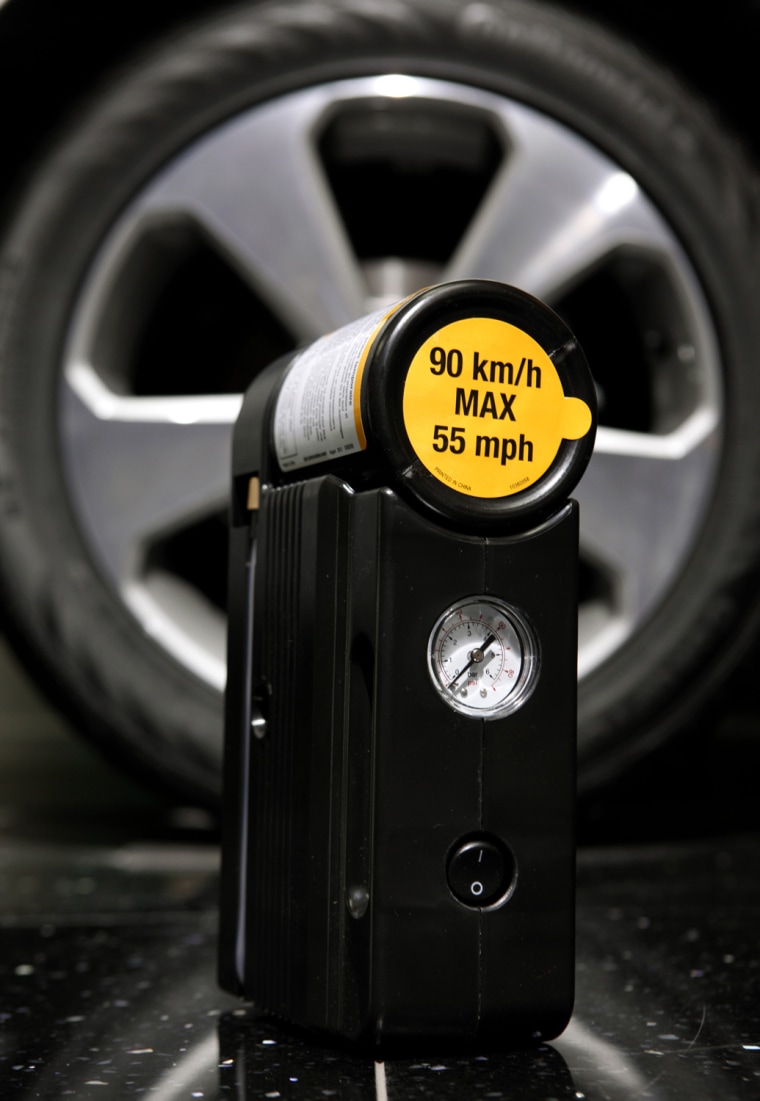Say you just bought a new car, and the right front tire goes flat as you're driving down the freeway.
Don't be surprised if there's no spare when you look in the trunk.
This year, more than 14 percent of new models on sale in the United States came with liquid tire sealant and a portable electric air pump instead of a spare, a trend that is growing as automakers try to shed pounds and boost gas mileage.
But there can be problems. While the sealant works well in most cases, you could be stuck on the shoulder if the hole that caused the flat is larger than a quarter of an inch, or if the puncture is on the side of the tire. In those cases, the only option is to have your car towed, and you may have to wait for a repair shop to track down a new tire.
"The last thing you want to do is find out the hard way that you don't have a spare tire if you're stranded on the side of the road," said Gene Petersen, tire program leader for Consumer Reports magazine.
However, General Motors Co., Hyundai Motor Co. and other automakers that use the pump-and-sealant kits say they have many advantages, mainly the weight savings. The kits are about 20 pounds lighter than a temporary spare and the jack and other tools needed to put on the tire. Also, the inflator kits don't take up as much room in the trunk, leaving more space for luggage or other cargo.
GM, which has made inflators and sealant standard on all but five of its 22 U.S. car and crossover models, said the kits can fix 85 percent of tire punctures. They're easy to use, even for someone who might be afraid of changing a tire, and they're safer because tires can be quickly refilled, getting the driver off the roadside and back in traffic faster than putting on a spare, said Dave Cowger, GM's tire engineering group manager.
Hyundai says the inflator kits help avoid another problem: getting dirty while changing a tire yourself. All you do is attach some tubes and fill the tire with sealant and air.
GM's market research, Cowger said, shows that half of consumers would call for roadside assistance rather than using a spare.
Also, new cars now come with electronic tire pressure monitors, so a slow leak in a tire is likely to be detected and fixed before it causes problems on the road, Cowger said.
GM, like many automakers, offers car buyers the option of getting a spare tire, charging $100 to $150 more for them. Cowger wouldn't say if GM saves money by swapping inflator kits for spares.
But many new car buyers assume that they're getting a spare and don't ask about it, said Ronald Montoya, consumer advice associate with the Edmunds.com automotive website.
"Unfortunately, this is something that many of us don't think of when shopping for a car," he said.
Plus, new cars are often equipped with larger wheels and performance tires with smaller sidewalls than regular tires. That helps a car handle better, but the sides of those tires take more punishment from potholes and are more prone to sidewall punctures, said Petersen.
Still, for the 85 percent of flats that the sealant can fix, there are 15 percent that it can't.
That's why Honda Motor Co. uses spares on all its 2011 models, spokesman Chuck Schifsky said.
"An actual spare tire is the best backup system should a customer have a flat tire," he said. "This is especially true in cases where the tire is damaged beyond what the tire sealant and pump systems can repair."
Nick Romito, an auto finance underwriter from Antioch, Ill., not far from Milwaukee, said he wouldn't buy a car without a spare tire. "I don't have a lot of confidence in those sealant products," he said. His family recently bought two used Ford Fusion sedans, both of which have spares, because Romito fears that the sealant could fail after it's squirted into the tire and under pressure from compressed air.
Automakers, however, say the sealant is reliable, but they recommend checking a few miles after fixing a flat to see if the tire needs a little more air.
GM also recommends that people drive no more than 100 miles before getting a sealed tire repaired. Cowger said drivers can travel at normal highway speeds after sealing a leak.
Like it or not, automakers increasingly are getting rid of spares as they face pressure to meet stricter government fuel economy regulations. By 2025, the U.S. car and truck fleet will have to average 54.5 miles per gallon under the standards, which are being phased in gradually. That's about double what cars and trucks now get.
According to Edmunds, just over 6 percent of all new car models had only the inflator kits in 2009, but that more than doubled by 2011.
"They need to find any way they can to reduce the weight of the vehicle, which will in turn make it more fuel efficient," Montoya said.
